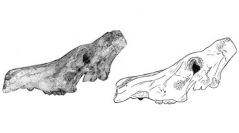

 Geodiversitas
23 (3) - Pages 411-437
Geodiversitas
23 (3) - Pages 411-437The suid material from four Turolian localities (MN11-13) in Bulgaria has been studied and compared. All specimens belong to Microstonyx major (Gervais, 1848), a common faunal element of the late Miocene South-East European faunas. The Greek and Bulgarian fossil record allows several suggestions to be made, concerning metrical and morphological features of Microstonyx major, as well as the species-level taxonomic diversity. The elaboration and evaluation of several characters allow us to distinguish three groups of M. major, in the Balkan territory. The first group (MN11-12) represents a small sized form, probably related with the Maragha suid (MN11). The second group (MN12-13) includes the typical M. major erymanthius and the third one M. major major (MN13). The last two groups indicate relation bet-ween them, as well as with the latest Vallesian Microstonyx major from Nikiti (end of MN10). The first group of Microstonyx major from Perivolaki, Kerassia and Vathylakkos probably consists in new subspecies, characterized by small to medium sized toothrow, small third molar and relatively elongated premolar row. The molar row reduces from the early to the middle Turolian representatives of the group.
Mammalia, Suidae, Microstonyx, late Miocene, Bulgaria, Greece, fossil species